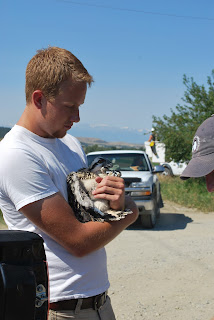 |
| Headwaters of the Yellowstone River in all of its majesty |
 |
| Mornings on Yellowstone Lake |
The birds. Oh the birds. They were spectacular. What I saw was something special. What first stood out to me was how many American White Pelicans were soaring over Yellowstone Lake as we canoed towards our destination. As we started crossing the open waters I noticed a large white blur off to the East. What I was seeing was Molly Island. What makes Molly Island special is that it is one of the few remaining breeding grounds for American White Pelicans. That was a special thing. I am in one of the most remote places of the lower 48 and here is place that is vital to the pelicans. Later on that day when we had been at camp for some time I heard a call that I have only ever heard once before and right away I knew it was something special. Trumpeter Swans. While I was never able to get close to them, this population of Trumpeter Swans was unique. It is one of the last resident populations. Most swans are only here for a portion of the year but this birds endure the harsh seasons that Yellowstone National Park can produce. Among the other birds was a flock of probably 2500 American Coots, a number of raptors including Coopers Hawks, several Red-tailed Hawks, an Osprey chick, and several Bald Eagles.
The Bald Eagles were amazing both in their beauty and what they represent. As you all know, they are a symbol of freedom to the United States. As I look back on when they flew by me on the shores of Yellowstone Lake I know they were more than just birds to me. I've been feeding an idea lately. We are very blessed to live in a country that we can argue about nature. Obviously, not every decision made regarding the environment is going to please everyone, but isn't it amazing we can discuss environmental problems? In some countries with a more command and control style that is simply not an option. But here we can work towards the preservation of the places that mean the most to us. And so here I am standing on the shores of a lake in one of the most federally protected lands in the United States and a Bald Eagle flies by. Again, I just had to take it in and treasure that moment.
 | |
| Heading towards the headwaters |
I want to publicly thank those that have been involved both with my internship and with the osprey research project. There is a huge list of people to thank. Steve Regele, Kayhan Ostovar, Lucas Ward, Emily Ward, Marco Restani, and Monty Sullins have all been monumental in making a dream come true. There are many more from power company employees to city government officials to citizen scientists. Never in my wildest dreams did I ever think that I would be where I am at today. Thank you!









